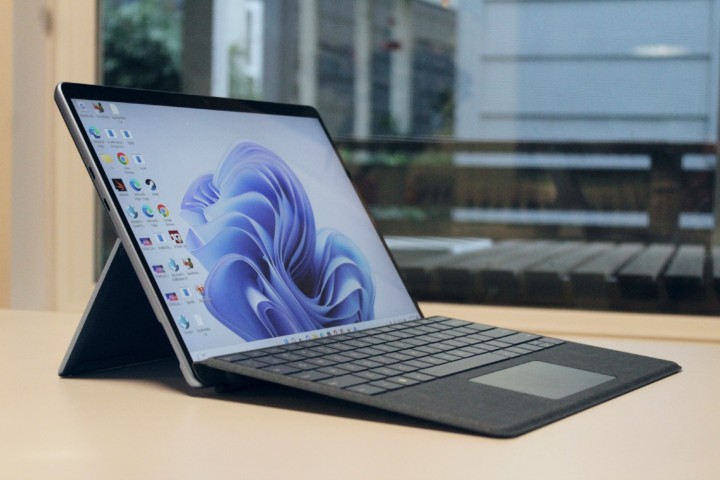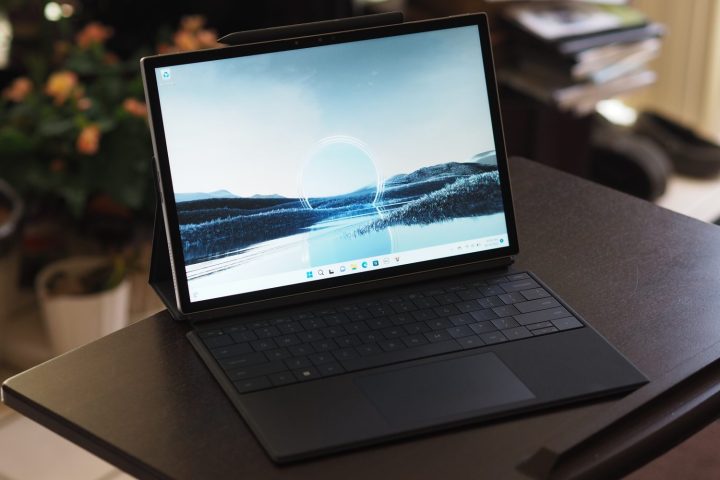Microsoft has had almost a decade to perfect the Surface Pro detachable tablet, culminating in the Surface Pro 9 that promises to hold on to the laptop’s place as the best 2 in 1. Dell just recently introduced the brand-new XPS 13 2-in-1 detachable tablet, a complete redesign from the previous 360-degree convertible 2-in-1 format.
Challenging such an established standard with so many years to refine its design is no small feat. Does the XPS 13 2-in-1 have what it takes to replace the Surface Pro 9 as the best detachable tablet 2-in-1?
specs
| Microsoft Surface Pro 9 | Dell XPS 13 2-in-1 | |
| Dimension | 11.3 inches by 8.2 inches by 0.37 inches | 11.5 inches x 7.9 inches x 0.29 inches |
| weight | 1.94 pounds | 1.23 pounds |
| processor | Intel Core i5-1235U Intel Core i7-1255U Microsoft SQ 3 (5G models) |
Intel Core i5-1230U Intel Core i7-1250U |
| Graphics | Intel Iris Xe Microsoft SQ 3 Adreno (5G models) |
Intel Iris Xe |
| R.A.M. | 8GB to 32GB LPDDR5 8GB or 16GB LPDDR4x (5G model) |
8GB or 16GB LPDDR4x |
| screen | 13-inch 3:2 PixelSense 2,880 x 1,920 IPS up to 120Hz | 13-inch 3:2 2,880 x 1,920 IPS |
| Storage | 128GB to 1TB removable PCIe SSD 128GB to 512GB removable PCIe SSD (5G models) |
512GB or 1TB PCIe SSD |
| touch | yes | yes |
| ports | 2 x USB-C with Thunderbolt 4 1 x Surface Connect port 1 x Surface Keyboard port 1 x nano SIM (5G models) 2 x USB-C 3.2 (5G models) |
2 x USB-C with Thunderbolt 4 1 x USB-C to USB-A adapter 1 x USB-C to 3.5mm audio jack adapter 1 x nano SIM (optional) |
| Wireless | WiFi 6E and Bluetooth 5.1 Optional 5GB WWAN |
WiFi 6E and Bluetooth 5.1 Optional 5GB WWAN |
| cam | 1080p with infrared camera for Windows 11 Hello 10MP rear facing |
1080p with infrared camera for Windows 11 Hell0 2160p rear facing |
| operating system | windows 11 | windows 11 |
| batteries | 60 watt hour | 49.5 watt hour |
| Price | $1,000+ | $1,000 |
| rating | 3.5 out of 5 | 3.5 out of 5 |
Price and configurations
The Surface Pro 9 Intel-based entry-level configuration is $1,000 for a Core i5, 8GB of RAM, and a 128GB SSD. The most expensive model is $2,600 for a Core i7, 32GB of RAM, and a 1TB SSD. The 5G ARM-based model starts at $1,300 for a Microsoft SQ 3 CPU, 8GB of RAM, and a 128GB SSD and ranges up to $1,900 with 16GB of RAM and a 512GB SSD. You’ll spend an additional $280 for the Surface Signature Type Cover and Surface Slim Pen 2.
The XPS 13 2-in-1 starts at the same $1,000 for a Core i5, 8GB of RAM, and four times the storage at 512GB. Fully configured, Dell’s tablet is $1,500 for a Core i7, 16GB of RAM, and a 1TB SSD. The XPS Folio and XPS Stylus are an additional $100 when configured with the system. That makes the XPS 13 2-in-1 a better value at the entry-level configuration, thanks to the additional storage, and is considerably less expensive for the high end, work with less RAM.
design
- 1.
Microsoft Surface Pro 9 - 2.
Dell XPS 13 2-in01
The Surface Pro 9 retains the rounded edges, aluminum construction, and smaller bezels of the previous generation, with the usual Surface build quality that ranks the tablet as one of the most attractive and solid you can buy. It’s available in Platinum, Sapphire, Forest, and Graphite colors in the Intel version, and Graphite in the 5G version. The XPS 13 2-in-1 is also solidly built, with square corners, even smaller bezels, and an aluminum frame around a glass back that optimizes for wireless connectivity. It’s available in Sky and Slate, with its 5G version available only in Slate.
The biggest point of distinction between the convertible tablets is the Surface Pro 9’s integrated kickstand with its wide range of angles. The XPS 13 2-in-1 lacks that feature, meaning Microsoft’s tablet is much easier to use on its own. With Dell’s model, you must attach the folio to prop up the tablet and you get just three angles determined by magnets on the tablet’s rear side.
In addition, the Microsoft Surface Type Cover props up at an angle for more comfortable typing, while the Dell XPS Folio keyboard only lies flat. That’s much less comfortable, even though the XPS Folios edge-to-edge keyboard with precise, snappy switches might be more comfortable than the Type Cover’s deeper but not as precise versions. The touchpads on both are similar in size and work fine.
The XPS 13 2-in-1 has fairly typical pen support with the XPS Stylus and its 4,096 levels of pressure sensitivity and tilt functionality. The Surface Slim Pen 2 has those features as well as haptic feedback that makes for a more realistic experience, and the Surface Pro 9’s 120Hz display provides for smoother inking.
Both tablets have 1080p webcams with infrared cameras for Windows 11 Hello passwordless login via facial recognition, while the XPS 13 2-in-1 also features a fingerprint reader. The Surface Pro 9 specs show a 2160p rear-facing camera while the XPS 13-in-1 has a 10MP camera.
Both the XPS 13 2-in-1 and the Surface Pro 9 Intel version have the same number of Thunderbolt 4 ports, and neither has a 3.5mm audio jack. The Surface Pro 9 5G version has USB-C 3.2 instead, thanks to the Qualcomm Snapdragon chipset. Microsoft’s tablet also has a Surface Connect port for power, whereas the XPS 13 2-in-1 must use one of its USB-C ports to charge up. The XPS 13 2-in-1 offers optional 5G WWAN connectivity, while you have to purchase the ARM-based 5G Surface Pro 9 for always-connected internet.
performance
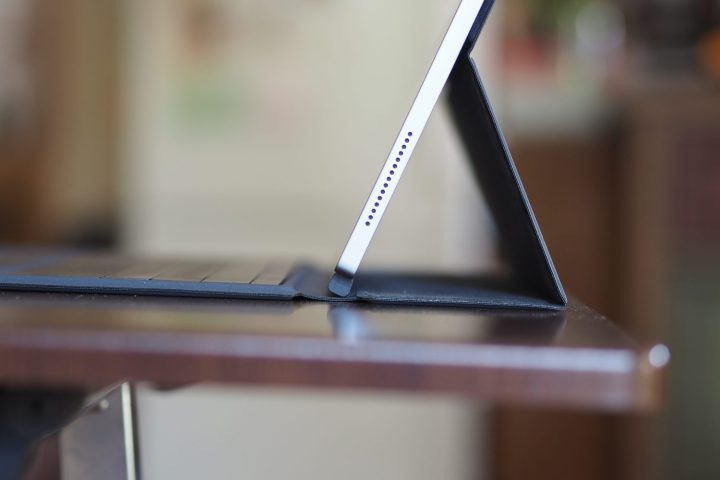 Mark Coppock/Digital Trends
Mark Coppock/Digital Trends
The Surface Pro 9 uses 15-watt Intel 12th-gen U-series CPU, specifically the 10-core/12-thread Core i5-1235U and Core i7-1255U. We reviewed the XPS 13 2-in-1 that uses 9-watt chips, the Core i5-1230U and Core i7-1250U with 10 cores and 12 thread, and the tablet with the Core i5.
Unsurprisingly, the Surface Pro 9 was faster in our benchmarks. The differences in Geekbench 5 and our Handbrake test that encodes a 420MB video as H.265 weren’t as significant as the huge discrepancy in Cinebench R23. The XPS 13 2-in-1 is fanless, and perhaps that caused some throttling in this CPU-intensive benchmark.
Note that there’s also a 5G Surface Pro 9 running a Microsoft version of the Qualcomm Snapdragon 8cx Gen 3 ARM processor. That machine is likely to be considerably slower than both Intel tablets.
| Microsoft Surface Pro 9 (Core i7-1255U) |
Dell XPS 13 2-in-1 (Core i5-1230U) |
|
| Geekbench 5 (single / multiple) |
Ball: 1.170 / 6.518 Perf: 1.598 / 8.165 |
Bal: 1.435 / 6.099 Perf: 1.572 / 7.028 |
| handbrake (seconds) |
Ball: 166 Perf: 127 |
Ball: 139 Perf: 144 |
| Cinebench R23 (single / multiple) |
Bal: 1.124 / 7.537 Perf: N/A |
Bal: 1.064 / 3.032 Perf: 1.065 / 3.009 |
| PCMark 10 Complete (higher is better) |
4,045 | 4,535 |
screen
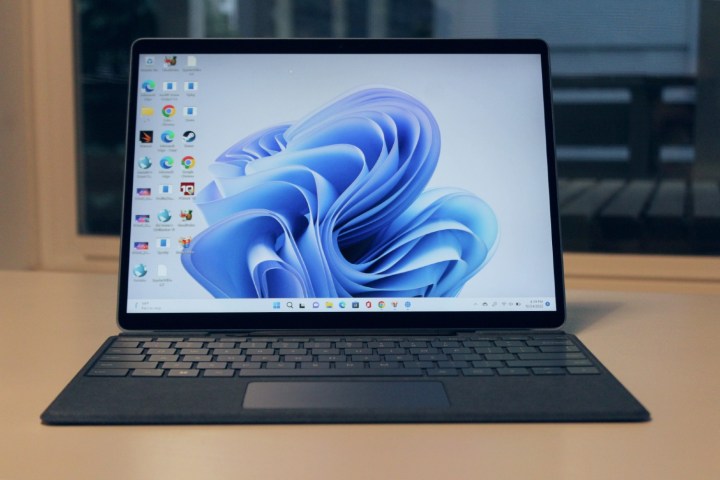
Both laptops utilize 3:2 2,880 x 1,920 IPS displays, but the XPS 13 2-in-1’s panel is slightly smaller and so sharper. The Dell also had significantly higher brightness and contrast and better color accuracy, making it a more pleasant display for demanding productivity work. Neither laptop has wide enough colors for creators.
Where the Surface Pro 9 display wins out is in its 120Hz refresh rate. That makes for better inking and an overall smoother Windows 11 experience. It’s also great for gaming at higher frame rates. Though neither of these laptops is designed with that in mind, their onboard GPUs are enough for very lightweight esports play.
| Microsoft Surface Pro 9 (IPS) |
Dell XPS 13 2-in-1 (IPS) |
|
| Brightness (nit) |
409 | 480 |
| AdobeRGB gamut | 80% | 78% |
| sRGB gamut | 99% | 99% |
| Accuracy (DeltaE, lower is better) |
1.24 | 0.8 |
| Contrast ratio | 1.050:1 | 1.840:1 |
Portability
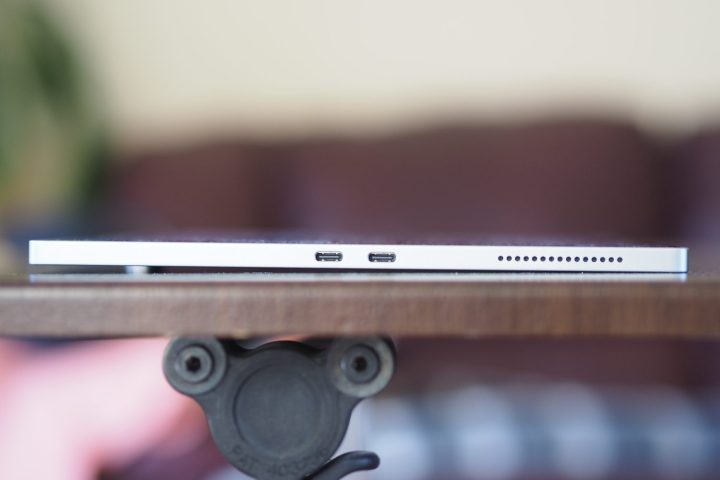 Mark Coppock/Digital Trends
Mark Coppock/Digital Trends
The XPS 13 2-in-1 is slightly thinner than the Surface Pro 9 at 0.29 inches versus 0.37 inches and lighter at 1.23 pounds versus 1.97 pounds. Both are light and small enough to slip comfortably in a backpack, but the Surface Pro 9 is more comfortable to use without the bulk of its detachable keyboard.
The Surface Pro 9 was stronger in battery life thanks to its larger battery. It lasted about eight hours in our web browsing test, for example, compared to the XPS 13 2-in-1 at just six hours. The 5G Surface Pro 9 would likely get significantly better battery life overall.
The Surface Pro 9 is better, but a lot more expensive
The Surface Pro 9 is the better detachable tablet 2-in-1, in terms of its inking experience, performance, and battery life. It’s also more expensive than the XPS 13 2-in-1, which does offer 5G connectivity in its Intel version.
Overall, Microsoft’s Surface Pro 9 is the better machine — just be ready to pay a lot more for it.
Editors’ Recommendations
